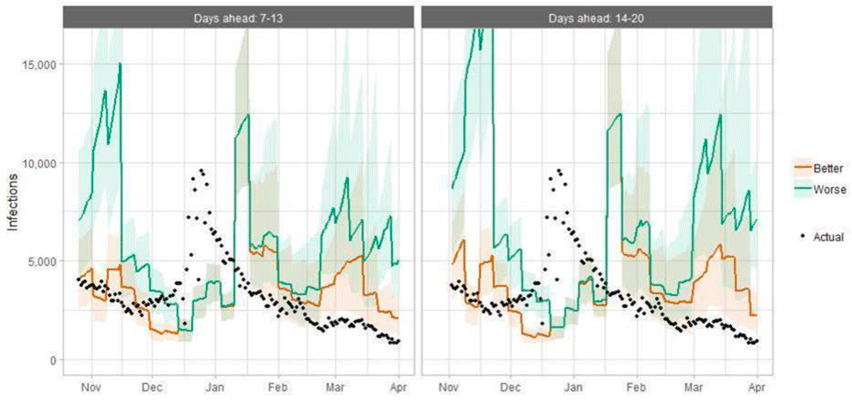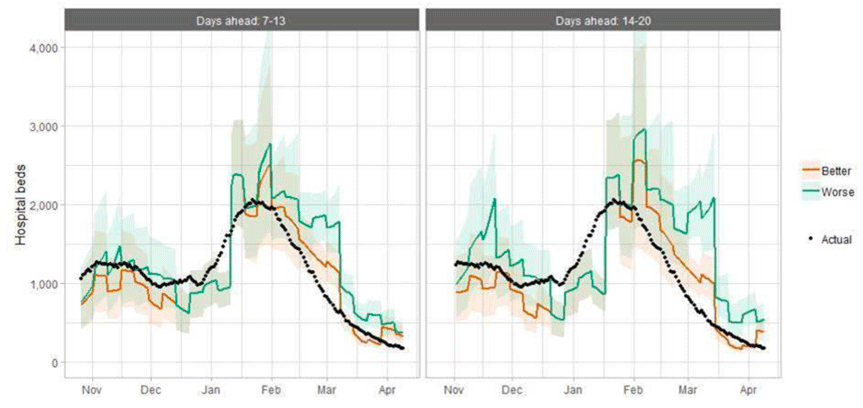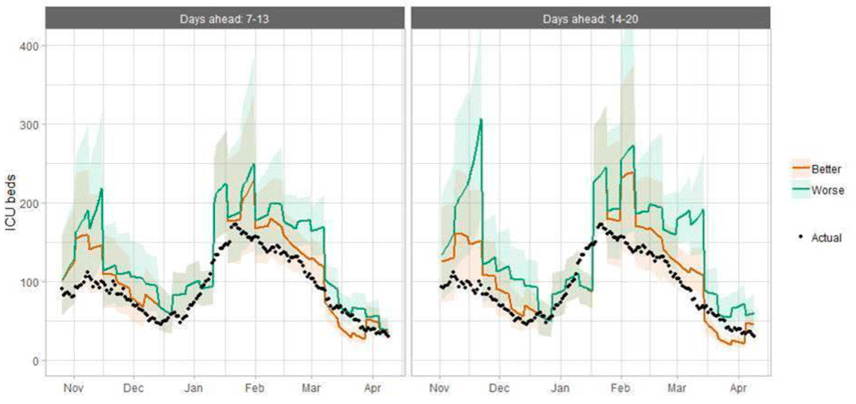Coronavirus (COVID-19): modelling the epidemic (issue no. 47)
Latest findings in modelling the coronavirus epidemic in Scotland, both in terms of the spread of the disease through the population (epidemiological modelling) and of the demands it will place on the system, for example in terms of health care requirements.
This document is part of a collection
Technical Annex
How the modelling compares to the real data as it emerges
The following charts show the history of our modelling projections in comparison to estimates of the actual data. The infections projections were largely accurate during October to mid-December and from mid-January onward. During mid-December to mid-January, the projections underestimated the number of infections, due to the unforeseen effects of the new variant.

Hospital bed projections have generally been more precise than infections estimates due to being partially based on already known information about numbers of current infections, and number of people already in hospital. The projections are for number of people in hospital due to Covid-19, which is slightly different to the actuals, which are number of people in hospital within 28 days of a positive Covid-19 test.

As with hospital beds, ICU bed projections have generally been more precise than infections. The projections are for number of people in ICU due to Covid-19. The actuals are number of people in ICU within 28 days of a positive Covid-19 test up to 20 January, after which they include people in ICU over the 28 day limit.

| LA | P (Cases > 500) | P (Cases > 300) | P (Cases > 100) | P (Cases > 50) |
|---|---|---|---|---|
| Aberdeen City | 0-5% | 0-5% | 0-5% | 5-15% |
| Aberdeenshire | 0-5% | 0-5% | 0-5% | 0-5% |
| Angus | 0-5% | 0-5% | 0-5% | 0-5% |
| Argyll and Bute | 0-5% | 0-5% | 0-5% | 0-5% |
| City of Edinburgh | 0-5% | 0-5% | 0-5% | 0-5% |
| Clackmannanshire | 0-5% | 5-15% | 25-50% | 25-50% |
| Dumfries & Galloway | 0-5% | 0-5% | 0-5% | 0-5% |
| Dundee City | 0-5% | 0-5% | 0-5% | 5-15% |
| East Ayrshire | 0-5% | 0-5% | 0-5% | 5-15% |
| East Dunbartonshire | 0-5% | 0-5% | 0-5% | 0-5% |
| East Lothian | 0-5% | 0-5% | 0-5% | 0-5% |
| East Renfrewshire | 0-5% | 0-5% | 0-5% | 5-15% |
| Falkirk | 0-5% | 0-5% | 0-5% | 5-15% |
| Fife | 0-5% | 0-5% | 0-5% | 15-25% |
| Glasgow City | 0-5% | 0-5% | 0-5% | 5-15% |
| Highland | 0-5% | 0-5% | 0-5% | 0-5% |
| Inverclyde | 0-5% | 0-5% | 0-5% | 5-15% |
| Midlothian | 0-5% | 0-5% | 0-5% | 0-5% |
| Moray | 0-5% | 0-5% | 0-5% | 15-25% |
| Na h-Eileanan Siar | 0-5% | 0-5% | 0-5% | 0-5% |
| North Ayrshire | 0-5% | 0-5% | 0-5% | 0-5% |
| North Lanarkshire | 0-5% | 0-5% | 0-5% | 5-15% |
| Orkney Islands | 0-5% | 0-5% | 0-5% | 0-5% |
| Perth and Kinross | 0-5% | 0-5% | 0-5% | 0-5% |
| Renfrewshire | 0-5% | 0-5% | 0-5% | 15-25% |
| Scottish Borders | 0-5% | 0-5% | 0-5% | 0-5% |
| Shetland Islands | 0-5% | 0-5% | 5-15% | 5-15% |
| South Ayrshire | 0-5% | 0-5% | 0-5% | 0-5% |
| South Lanarkshire | 0-5% | 0-5% | 0-5% | 0-5% |
| Stirling | 0-5% | 0-5% | 0-5% | 5-15% |
| West Dunbartonshire | 0-5% | 0-5% | 0-5% | 0-5% |
| West Lothian | 0-5% | 0-5% | 0-5% | 5-15% |
The local estimates should be interpreted with caution as they are based on fewer models than previous reports.
Exceedance
Exceedance is defined by Health Protection Scotland as a greater than expected rate of infection compared with the usual background rate for the place and time where the incident has occurred[11]. We assume that the daily number of new positive cases should fall within a certain distribution of values, given the number of tests carried out each day, and the proportion of those we expect to be positive.
The probability of getting the observed value of positive tests or greater can then be calculated. If this probability is small, the daily number of positive cases is much larger than would be expected by chance. We can now provide this at Local Authority level in Scotland using a model developed and run by Warwick University using Scottish testing data.
We can aggregate positive test results across several days to identify periods when the proportion of confirmed infections is high. This "cumulative exceedance" measure is more robust as it smooths variability in the data caused by, for example, multiple cases within larger households. As this cumulative exceedance value falls back to background levels, we can be confident that any outbreaks have been dealt with.
Daily Exceedance
The daily exceedance is a measure of how far above the expected number of positive tests today's results are, based on the number of tests, the national tests and the particular attributes of each Local Authority.
The expected proportion of positive tests for a given Local Authority is based on the daily pattern of positive tests from elsewhere in the country (and hence naturally accounts for the impact of both a declining epidemic and the impact of weekend effects); this value is scaled by the mean proportion of positive tests in the Local Authority over the past six weeks. We assume that the daily number of new positive cases should be drawn from a binomial distribution for the given number of tests and the expected proportion positive. The probably of getting the observed value or above can then be calculated. When this is small, the daily number of positive cases is much larger than would be expected by chance. We define the exceedance as:
- log (probability of getting today's number of positive cases or higher by chance)
Large values correspond to highly unlikely large positive values.
Recent Cumulative Exceedance
We can apply this approach backwards in time, to assess whether a Local Authority has had consistently high values over a period of many days. Again assuming a binomial distribution, we calculate the probability of observing the given cumulative number of positive cases over a given period compared with the expected number.
Contact
There is a problem
Thanks for your feedback